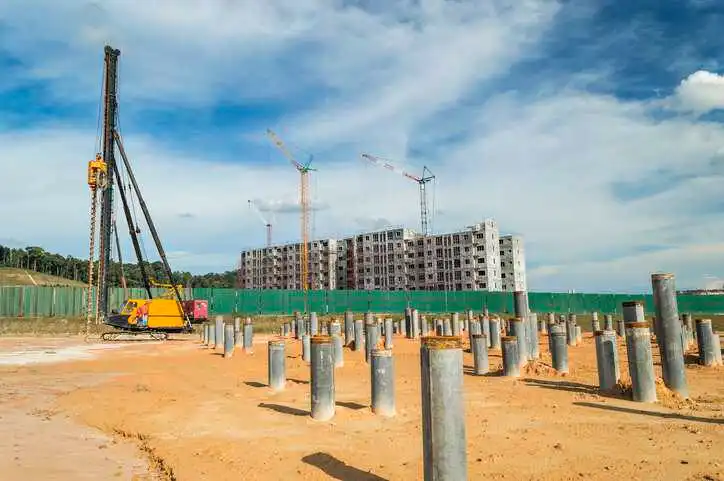ANSI/ASSP A10.19-2023: Driven Piles

Pile driving is often used to construct foundation supports for buildings and other structures. ANSI/ASSP A10.19-2023: Safety Requirements For Driven Pile Installations And Extraction Operations applies to workplaces where employees are exposed to hazards associated with driven pile installation and extraction operations during construction and demolition operations.
What Are Driven Piles?
A driven pile is a relatively long, slender column, provided to offer support or to resist forces. The prefabricated column is made of preformed material (e.g., timber, steel, or concrete) having a predetermined shape and size. It is then driven into the earth by using specialized equipment like impact or vibration hammers. Simply put, driven piles are deep foundation elements.
Driven piles may conveniently be used in locations where it is advised not to drill holes due to groundwater pressure. They are also preferred for works over water, like piles in wharf structures or jetties. To assure the safe installation of driven piles, ANSI/ASSP A10.19-2023 provides requirements.
What Is ANSI/ASSP A10.19?
ANSI/ASSP A10.19-2023 establishes safety requirements for the installation and extraction of driven piles during construction and demolition operations. This American National Standard applies to driven piles comprised of hot and cold rolled steel, concrete, wood, and composite materials. ANSI/ASSP A10.19-2023 aims to prevent injuries and illnesses to persons exposed to hazards associated with pile driving and extraction operations.
This standard does not apply to structural steel erection covered by ANSI/ASSP A10.13, Safety Requirements for Steel Erection, or jacking or caisson operations covered by ANSI/ASSP A10.16, Safety Requirements for Tunnels, Shafts and Caissons.
What Is the Purpose of Driving Piles?
Pile driving is a critical and popular construction and engineering method because it assures stability and durability of large structures, such as in the event of earthquakes. The method entails driving embed vertical columns made of various materials (wood, concrete, steel, or a combination) into un-excavated soil. Essentially, pile driving installs long, slender support structures into the ground.
This process uses a large machine to drive the piles into the earth until they reach the required depth. The piles create a deep foundation for the large structure being built (often bridges) and are used to hold the large structure in place. The common uses and purposes for driven piles include structural support and earth retention for retaining walls and soundwalls as well as helping install fencing, bulkheads, ooring structures, anchorage structures, cofferdams, erosion control barriers, and signposts.
Advantages of Pile Driving
Here are several advantages of pile foundations:
- You can order it in advance
- Driven piles maintain their shape during installation
- It is highly customizable as piles can be precast in a variety of sizes and shapes
- Shortened the building time for a fast installation
- Widely used and suited to most ground conditions
- The pile will be more securely fixed into the ground since driving compacts the adjacent soil
- Environmentally friendly because the combination of more efficient deliveries to the site with no need to dispose of spoil reduces the CO2 footprint of driven piles
- Ideal for deep installations
- Best for wetlands
- Long-lasting
- Suitable for places where it is hard to drill and make holes
ANSI/ASSP A10.19-2023: Safety Requirements For Driven Pile Installations And Extraction Operations is available on the ANSI Webstore and in this Standards Package: ANSI/ASSP. A10 Construction Package.






